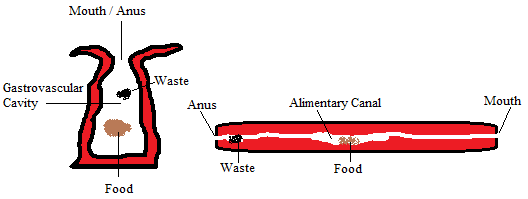BIO 112 Notes: Animal Nutrition
Categories of nutrition that animals fall under
- Food is ==taken in, taken apart, and taken up== in the process of animal nutrition.
In general, animals fall into three categories.
- ==Herbivores==, which eat mainly plants and algae.
- ==Carnivores==, which eat other animals.
- And ==omnivores==, which regularly consume animals as well as plants or algae.
Overall, most animals are also ==opportunistic== feeders.
Essential nutrients
Essential nutrients are ==required by cells== and ==must be obtained from dietary sources==.
There are four classes of essential nutrients:
- ==essential amino acids==
- ==essential fatty acids==
- ==vitamins==
- ==minerals==
An example of an essential amino acid is ==methionine==. An essential fatty acid is ==linoleic acid== (LA), which is an omega-6 fatty acid. An example of a vitamin is ==Vitamin C,== which is found in fruits. An example of a mineral is ==calcium==, which is found in bones.
Stages of food processing
Food processing can be divided into four distinct stages
- ==Ingestion==
- ==Digestion==
- ==Absorption==
- ==Elimination==
Ingestion is the act of ==eating or feeding==. Digestion is the process of ==breaking down food== into molecules small enough to absorb. Absorption is the ==uptake of nutrients== by body cells. Elimination is the ==passage of undigested material out of the digestive system.==
Food processing: ingestion, digestion, absorption, elimination
Difference between intracellular and extracellular digestion
In ==intracellular== digestion, food particles are engulfed by ==phagocytosis==.
==Extracellular== digestion is the ==breakdown of food particles outside of cells.==
- Intracellular digestion takes place in ==unicellular== organisms such as protozoans while extracellular digestion occurs in ==animals and fungi.==
Types of digestive compartments found in animals using extracellular digestion
Animals with ==simple== body plans have a ==gastrovascular cavity== that functions in both digestion and distribution of nutrients.
More ==complex== animals have a complete digestive tract or an ==alimentary canal== with a mouth and an anus. The alimentary canal can have specialized regions that carry out digestion and absorption in a stepwise fashion.
==Simple body plan: gastrovascular cavity. Complex body plan: alimentary canal (specialized)==

Evolutionary adaptations of the vertebrate digestive system
- ==Dentition==, an animal’s assortment of teeth, is one example of structural variation reflecting diet. The success of mammals is due in part to their dentition, which is specialized for different diets.
- Vertebrates also have ==stomach and intestinal adaptations==. Herbivores and omnivores generally have longer alimentary canals than carnivores, reflecting the longer time needed to digest vegetation.
- ==Mutualistic adaptations== in humans have also been formed to correlate with diet. Some intestinal bacteria produce vitamins; others regulate the development of intestinal epithelium and the function of the innate immune system.
Many vertebrates also host mutualistic bacteria and protists in the ==fermentation chambers== of their alimentary canals. These microorganisms can ==digest cellulose== to simple sugars and other compounds.
Dentition: an animal’s assortment of teeth
Herbivores and omnivores: have longer alimentary canals
Intestinal bacteria: produce vitamins
Mutualistic bacteria: digest cellulose in some animals